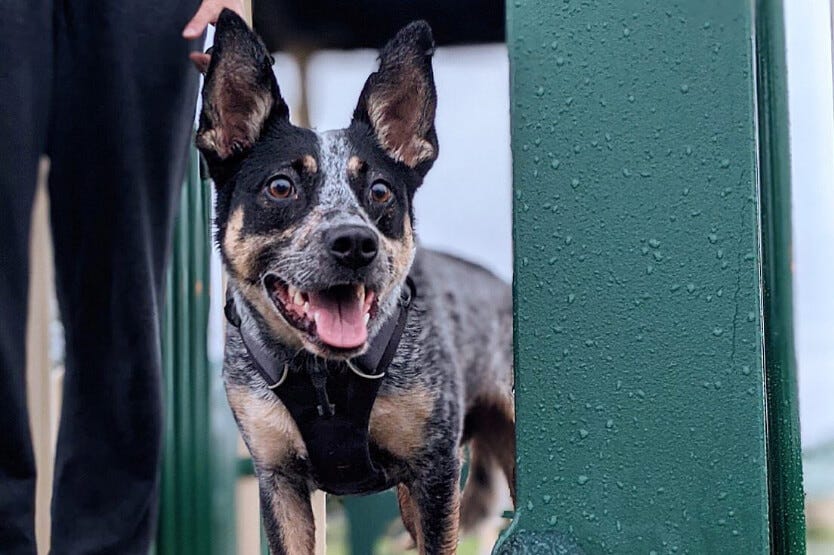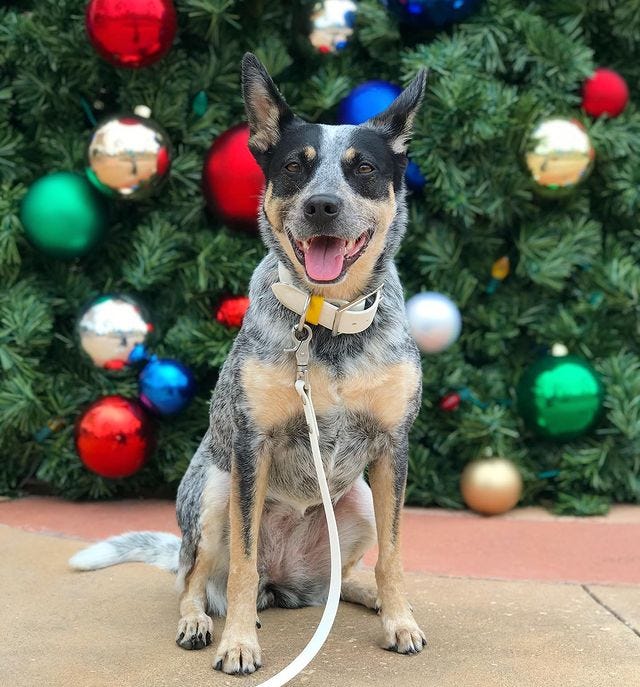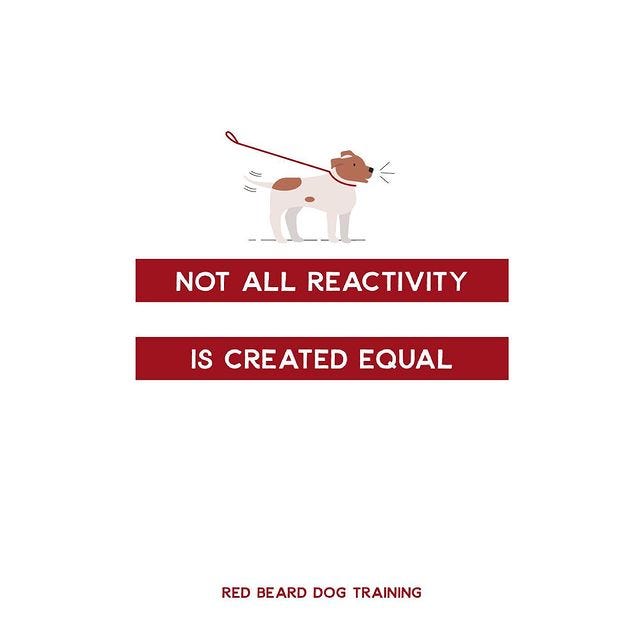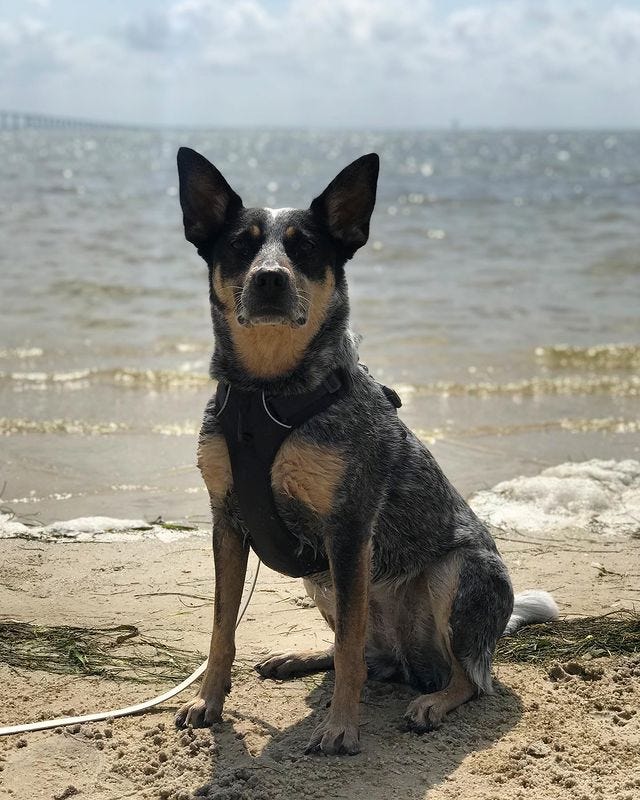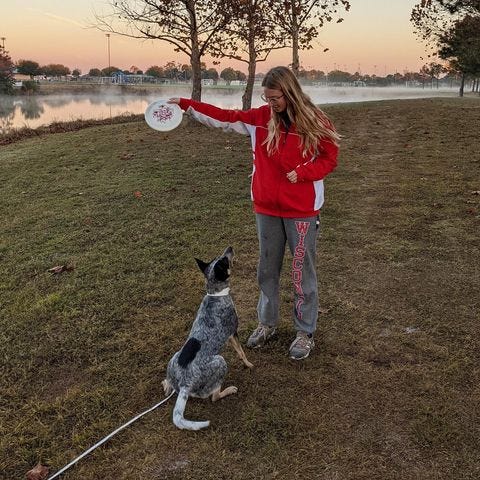Don’t compare your dog reactivity journey to others
Since adopting my Australian cattle dog, Scout, I’ve talked a lot about how dog reactivity can be isolating and overwhelming. But there’s also a huge community for it. (Just take a look at “reactive dog” hashtags on social media.)
And to be honest? Sometimes being surrounded by so many voices feels even worse than being alone.
While it’s reassuring to know that my dog and I aren’t the only ones who struggle, discovering the reactive dog world means I now have hundreds of examples to compare ourselves to.
Here’s why those comparisons can hurt more than they help—and how I’ve learned (and am still learning!) to fight my natural inclination to make them.
First: There are multiple definitions of dog reactivity
“What is dog reactivity?” is a loaded question if I’ve ever heard one.
Owners and trainers frequently use the term in slightly different ways. Usually, “reactive” denotes a dog who reacts inappropriately to stimuli in his or her environment.
Technically, every dog is reactive in the sense that every dog reacts in some way to what’s going on. A glance is a reaction. A yawn is a reaction. Making space is a reaction.
When talking dog training, though, the label “reactive” usually indicates that a dog reacts in ways we humans find inappropriate. Think things like lunging, flipping at the end of the leash, baring teeth, growling, barking, standing on hind legs, or any other behavior that looks reasonably terrifying to a bystander.
Not everyone uses the word “reactive” in the same way
The ambiguity of the term can cause issues if we start to assume that everyone is using the “reactive” label in the same way we are. If I judged Scout compared every other dog posted with #reactive on Instagram, she’d be up against thousands of different backgrounds, characteristics, and capabilities!
There are multiple causes of dog reactivity
Beyond unclear definitions, it’s also important to note that not all dog reactivity is created equal. Many different variables are at play when we have a reactive dog. The process to address their problematic behavior depends heavily on what’s causing it in the first place.
Fear-based reactivity
Scout’s dog reactivity, for example, is fear based. Her growling and barking and lunging fundamentally stem from being scared (which in itself could be part genetic, from unknown early experiences, and exacerbated by getting pinned on the sidewalk).
In the framework of blue ribbon emotions, here’s what would happen when she saw another dog:
She’d spot the scary thing and feel intense Fear
As she felt restrained (by the leash or simply in the space) and worried that the other dog would approach her, that fear would turn into frustration and then Rage
That Rage was responsible for the reaction I’d see (growling, barking, lunging, etc.)
That knowledge enabled me to come up with a foundational plan to work on her reactivity:
Improve her impulse control and frustration tolerance so she could handle higher levels of Rage without losing her head
Work to change her initial emotional response from Fear to Seeking when she saw another dog
Barrier frustration reactivity
Many other dogs have a form of barrier frustration reactivity. When an otherwise-friendly dog turns into a monster at the sight of other dogs on leash, it’s often because he or she really wants to “say hi” or investigate—and being contained creates frustration, which turns into more intense Rage.
This is an important distinction from fear reactivity because of the effect creating distance has. To a fearful dog, moving away from the trigger is reinforcing. To a dog who really wants to go forward, it’s the opposite.
General overarousal and layered stress
A dog who isn’t necessarily fearful can also be reactive simply because they are stressed. As triggers stack on top of each other—not feeling biologically fulfilled, lacking clarity, etc., etc.—we find ourselves in a “straw that broke the camel’s back” situation where it only takes one tiny stimulus to send them over the edge.
You can take a listen to Jay Jack’s GRC Dog Talk podcast on leash reactivity here. This is one of my all-time favorite podcast episodes in the history of… well, ever. I think it brings absolutely imperative perspective to what it’s like for our dogs to be on leash. You can also hear him talk about the layered stress model in this video!
Genetics, breed traits, etc.
Dogs can also be “reactive” because of poor genetics or specific breed traits that once had a purpose but now clash with modern-day pet life. For example, many herding and working breeds are deemed reactive because they can be hyper-aware and energetic.
Ultimately, every dog is an individual
It’s a nuanced conversation. On the one hand, we can’t get into our dogs’ heads to understand exactly what is causing a certain reaction. On the other, at least attempting to see where their behavior comes from can enable us to grow more effectively.
At the end of the day, every dog, owner, and situation is unique. Even if I meet someone whose dog’s reactivity is, on the surface, similar in cause and severity to Scout’s, there are countless other confounding variables that prevent me from making an accurate comparison!
“But so-and-so solved everything in just __ weeks!”
Yep, I know. And you’re incredibly happy for them. And also it kind of sucks to watch them have so much success, right? You feel like you’re behind, or not good enough, or a slew of other uncomfortable things.
I’ve been there.
It can be so hard to compare what Scout and I have accomplished with what other people have. Sometimes I feel crushed under self-doubt, wondering if I could be doing more, better, different… if I just changed this one thing, could I “fix” her? Have I been messing up all this time?
Those are powerful, hurtful thoughts—but they’re also unproductive. Here’s what I remember when I start focusing too much on someone else’s progress instead of my own.
Instagram and other social media is not real life
Social media is not real life. While there are definitely accounts that try to authentically share the good and bad (that’s always been the hope with ours) it’s simply not possible to paint a fully comprehensive picture on the internet.
We see our own dogs day in and day out—in all the little moments, in all the “between” times. It might sound cliched, but it’s true: When we compare our 24/7 behind-the-scenes with someone else’s 15-minutes-a-day highlight reel, it’s going to be inaccurate. End of story.
You might have different goals than them in the first place
A huge theme in my dog ownership journey (and my life as a whole) is that my goals don’t need to be the same as anyone else’s. I can set my own definition of success!
Sometimes I’ll see someone share their dog playing in a busy off-leash park or attending a huge festival full of other canines, and I’ll feel bad that Scout probably couldn’t handle that. Then I’ll ask myself this: Even if she could, is that an activity I’d want to do in the first place?
It’s easy to get caught up in wanting Scout to be “as good” as every other wonderful dog on social media. But really, I just want her to be good for our life—to have the skills she needs to thrive and live well with us.
Think about all the progress you have made
While it generally isn’t healthy to compare myself to other people, it can be productive to reflect on where we started. The only team we’re really trying to be better than is who we were yesterday!
If I start to get discouraged that Scout can’t do some of the things I see other dogs doing, I’ll remind myself of the many experiences we can easily enjoy today that felt impossible before:
Bringing her to a dog-friendly restaurant or just hanging out in public
Passing other dogs on narrow hiking trails
And so many more
Repeat over and over: Your dog is not their dog
I can’t say it enough. My dog is not their dog. My life is not their life. Their expectations don’t have to be my expectations.
We often place value judgments on things being “better” or “worse”. But if your lifestyle is working for you and your dog—if you’re both happy, and fulfilled, and safe / respectful to others in shared public spaces—then you’re doing it right.
The “reactive dog” community can be wonderful
There are so many different paths to similar end goals. So many different end goals. So many different dogs, so many different owners. None of our journeys look alike. Directly comparing them can hurt.
But sharing openly and encouraging those around us? That definitely helps.



